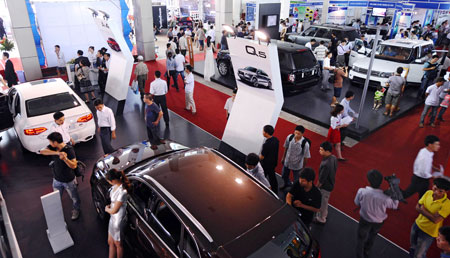Car fee hikes could slam brakes on auto industry growth

A file photo shows visitors to the Vietnam AutoExpo 2011 show in Hanoi last year. Industry insiders expect 2012 to be a difficult year for the auto sector
In the capital, the registration fee for cars with fewer than 10 seats has been raised from 12 per cent of the vehicle’s value to a full 20 per cent. Their license-plate fee was increased 10-fold to VND20 million ($950). In HCMC, the registration fee has gone up from 10 per cent to 15 per cent though the license plate fee has been left unchanged.
Akito Tachibana, president of Toyota Vietnam and chairman of the Vietnam Automobile Manufacturers’ Association, warning that the higher fees would have a negative impact on the auto market since it relies on Hanoi and HCMC, said Toyota would have to reconsider its production plans for this year.
The bustling crowds at auto showrooms in Hanoi at this time of the year – just before Tet – are gone.
Tran Quoc Khang, sales manager of the Hanoi-based Thang Long car dealership said: “The higher fees are a severe blow to sellers since 70 per cent of the total car sales are in Hanoi and HCMC.”
He said his company used to sell one or two cars a day until a few months ago, but has not sold even one this month.
The fee hikes have increased the cost of cars sharply, he said. “Thus, a fall in demand is inevitable.”
Cao Binh Phuong, a Hanoi construction engineer, said: “The increased price of cars along with high loan interest rates has made my dream of buying a car more difficult.”
Some used-car dealerships were hoping that the price hikes would see customers switch to second-hand cars, but the high inflation and economic slowdown have also hit that segment of the market.
“The situation has never been this bad,” said a representative of a second-hand car dealership in Hanoi. “There have been months we could not sell any vehicles. Our income is not enough to even pay our rents and salaries.”
Tachibana of Toyota Vietnam said auto manufacturers hope the government has a long-term strategy to develop the sector. They support the government’s plan to boost the automobile sector, but it can only happen when there is a stable tax policy, he said.
Analysts and industry insiders said Vietnam’s tax policies change frequently, severely affecting the stability of the auto sector.
Difficulties ahead
Khang expects 2012 to be a difficult year for the auto sector since monetary policy is still tight and public spending will remain low due to inflationary pressures. Higher automobile prices would make people hesitate more before deciding to buy, he said.
Central bank governor Nguyen Van Binh told an economic conference Wednesday that commercial banks will continue to limit lending to non-production businesses. The central bank is aiming for an overall credit growth of between 15 per cent and 17 per cent this year.
In view of the difficulties for the car market, members of the Vietnam Automobile Manufacturers’ Association are expected to cut output by 20 per cent this year. Sales last year dropped 1 per cent from 2010 to 110,938 cars, the association said.
Tachibana said carmakers should improve their competitiveness failing which they would have to shut down production and switch to importing cars.
An anticipated cut in auto import taxes is not expected to spur demand since car prices remain too high compared to the average income in Vietnam of around $1,200 a year.
The Association of Southeast Asian Nations, also known as ASEAN, which is the main beneficiary of the tariff cut, is not Vietnam’s primary car supplier, Khang said.
He was referring to the impending cuts in import duties on cars and trucks under agreements signed among members of ASEAN and between the bloc and China and South Korea. The tariffs on most cars exported by ASEAN members will be cut to 70 per cent this year, 60 per cent in 2013, and 50 per cent in 2014.
Vietnam is expected to have 28 cars per 1,000 population by 2015, 38 by 2020, and 88 by 2025, compared with the current 18, according to the Ministry of Industry and Trade.
Khuat Viet Hung of the University of Transport said in October that Hanoi had nearly 400,000 cars that used 55 per cent of the road space and 65 per cent of all parking space during peak hours.
What the stars mean:
★ Poor ★ ★ Promising ★★★ Good ★★★★ Very good ★★★★★ Exceptional
Related Contents
Latest News
More News
- Strengthening supply chains through trade promotions and customs reform (December 24, 2025 | 14:00)
- PM orders investment model for North–South high-speed rail (December 22, 2025 | 17:43)
- LS Eco Energy to invest in Vietnam rare earth sector (December 22, 2025 | 17:31)
- Government moves to establish International Financial Centre (December 21, 2025 | 21:00)
- Vietnam's IFC to target global investment flows (December 21, 2025 | 18:00)
- Two national hospitals expand capacity with new facilities (December 20, 2025 | 09:00)
- Ha Tinh breaks ground on major Vingroup industrial and energy projects (December 19, 2025 | 18:24)
- EVN launches major power infrastructure projects nationwide (December 19, 2025 | 18:17)
- VAL inaugurates second production line to meet domestic animal feed demand (December 19, 2025 | 16:37)
- Sun Group pioneers urban tram system in Phu Quoc (December 19, 2025 | 15:00)

 Tag:
Tag:






















 Mobile Version
Mobile Version